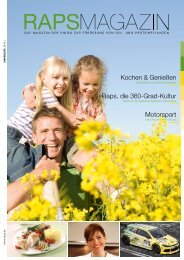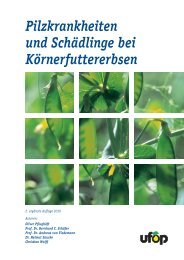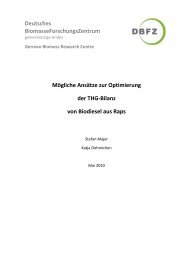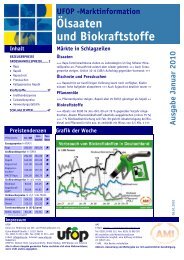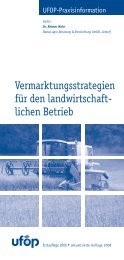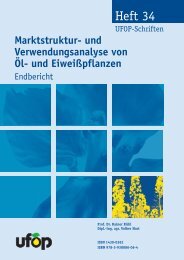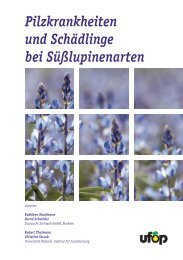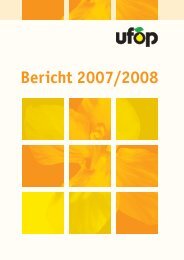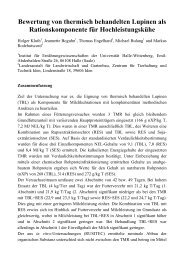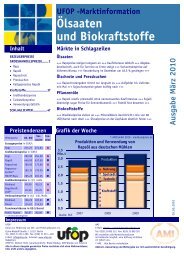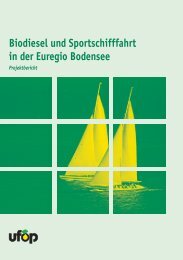Oil Dilution of a Passenger Car Diesel Engine in Operation with - Ufop
Oil Dilution of a Passenger Car Diesel Engine in Operation with - Ufop
Oil Dilution of a Passenger Car Diesel Engine in Operation with - Ufop
You also want an ePaper? Increase the reach of your titles
YUMPU automatically turns print PDFs into web optimized ePapers that Google loves.
OTTO-VON-GUERICKE<br />
UNIVERSITY MAGDEBURG<br />
Institute <strong>of</strong> Mobile Systems – Chair <strong>of</strong> Reciprocat<strong>in</strong>g Mach<strong>in</strong>es<br />
F<strong>in</strong>al Report Abstract<br />
”<strong>Oil</strong> <strong>Dilution</strong> <strong>of</strong> a <strong>Passenger</strong> <strong>Car</strong> <strong>Diesel</strong> <strong>Eng<strong>in</strong>e</strong><br />
<strong>in</strong> <strong>Operation</strong> <strong>with</strong> blended <strong>Diesel</strong> Fuel B10“<br />
Promotion code: 22010007 (07NR100)<br />
Promoted by:<br />
• Fachagentur Nachwachsende Rohst<strong>of</strong>fe e.V. (FNR<br />
• Union zur Förderung von Oel- und Prote<strong>in</strong>pflanzen e.V. (UFOP<br />
• Volkswagen AG Wolfsburg<br />
• Fuchs Europe Schmierst<strong>of</strong>fe GmbH<br />
Pr<strong>of</strong>. Dr.-Ing. Dr. h. c. H. Tschöke Dipl.-Ing. G. Braungarten Dipl.-Ing. U. Patze<br />
Chair <strong>of</strong> Reciprocat<strong>in</strong>g Mach<strong>in</strong>es Editor Editor<br />
Magdeburg, June 4, 2009
1 Introduction<br />
Currently Biodiesel (RME) is mixed accord<strong>in</strong>g to EN 14214 and EN 590 <strong>with</strong> up to 5% <strong>of</strong><br />
fossil <strong>Diesel</strong> fuel. With a further <strong>in</strong>crease <strong>of</strong> RME fraction to 10% (B10 blend), there are<br />
uncerta<strong>in</strong>ties regard<strong>in</strong>g the undisturbed longlife behavior due to variations <strong>of</strong> the physicochemical<br />
properties <strong>of</strong> RME <strong>in</strong> comparison to commercial <strong>Diesel</strong> fuel.<br />
It is known that an irreversible oil dilution appears <strong>in</strong> the eng<strong>in</strong>e lubrication system as a result<br />
<strong>of</strong> regeneration mode <strong>of</strong> current passenger car <strong>Diesel</strong> eng<strong>in</strong>es <strong>with</strong> particulate filters. The<br />
cause <strong>of</strong> these is the higher distillation characteristic <strong>of</strong> RME <strong>in</strong> contrast to the fossil <strong>Diesel</strong><br />
fuel. If unburnt fuel reaches the lubricant <strong>in</strong> the oil sump via the piston-cyl<strong>in</strong>der assembly<br />
dur<strong>in</strong>g the regeneration <strong>of</strong> the particulate filter, the RME fraction cannot evaporate from the<br />
eng<strong>in</strong>e oil due to its distillation characteristic (boil<strong>in</strong>g po<strong>in</strong>t > 340 °C) [1]. As a consequence <strong>of</strong><br />
the oil dilution, an irreversible decrease <strong>of</strong> the viscosity results <strong>with</strong> the risk <strong>of</strong> <strong>in</strong>creas<strong>in</strong>g<br />
wear [2].<br />
The eng<strong>in</strong>e bench tests carried out <strong>in</strong> this project should clarify whether the share <strong>of</strong> the<br />
RME fraction <strong>in</strong> the eng<strong>in</strong>e oil <strong>of</strong> a passenger car diesel eng<strong>in</strong>e equipped <strong>with</strong> a particulate<br />
filter and operated <strong>with</strong> B10 blend is higher than the share <strong>of</strong> the <strong>Diesel</strong> fuel fraction.<br />
The Fachagentur Nachwachsende Rohst<strong>of</strong>fe e.V. (FNR) and the Union zur Förderung von<br />
Oel- und Prote<strong>in</strong>pflanzen e.V. (UFOP) f<strong>in</strong>anced this project. It was supported by Volkswagen<br />
AG Wolfsburg <strong>with</strong> the provision <strong>of</strong> the diesel eng<strong>in</strong>e and by Fuchs Europe Schmierst<strong>of</strong>fe<br />
GmbH Mannheim, which provided and analyzed the eng<strong>in</strong>e oil.<br />
2 Tasks<br />
At the Institute for Mobile Systems IMS, Chair <strong>of</strong> Reciprocat<strong>in</strong>g Mach<strong>in</strong>es <strong>of</strong> the Otto-von-<br />
Guericke University Magdeburg, was tested a passenger car <strong>Diesel</strong> eng<strong>in</strong>e 2.0-l-TDI-CR-4V<br />
operat<strong>in</strong>g <strong>with</strong> B10 blend. The task was to measure at the eng<strong>in</strong>e test bench the entra<strong>in</strong><strong>in</strong>g <strong>of</strong><br />
fuel <strong>in</strong>to the eng<strong>in</strong>e oil and the discharge <strong>of</strong> fuel out <strong>of</strong> the oil <strong>in</strong> four different operat<strong>in</strong>g<br />
conditions. The eng<strong>in</strong>e <strong>with</strong> a rated power <strong>of</strong> 103 kW fulfilled the standard Euro 5 and was<br />
equipped <strong>with</strong> common rail <strong>in</strong>jection system, turbocharger, <strong>in</strong>tercooler, exhaust gas<br />
recirculation <strong>with</strong> low-temperature cool<strong>in</strong>g, and <strong>with</strong> upstream oxi-cat and particulate filter [3].<br />
Tab. 2-1 describes the four operat<strong>in</strong>g po<strong>in</strong>ts.<br />
Tab. 2-1 Operat<strong>in</strong>g po<strong>in</strong>ts <strong>of</strong> the eng<strong>in</strong>e 2.0 l TDI CR 4V, 103 kW<br />
OP n <strong>in</strong> r.p.m. T <strong>in</strong> Nm bmep <strong>in</strong> bar<br />
1 2140 30 1.9<br />
2 1000 17 1.1<br />
3 2000 250 16.0<br />
Idle 790 0 0<br />
The bench test<strong>in</strong>g should answer the follow<strong>in</strong>g questions:<br />
� At which <strong>of</strong> the operat<strong>in</strong>g po<strong>in</strong>ts OP1 to OP3 takes place the fuel (B10) entra<strong>in</strong><strong>in</strong>g <strong>in</strong>to<br />
the eng<strong>in</strong>e oil dur<strong>in</strong>g eng<strong>in</strong>e operation <strong>with</strong>out post-<strong>in</strong>jection?<br />
� What is the time-course <strong>of</strong> B10 blend entra<strong>in</strong><strong>in</strong>g for retarded post-<strong>in</strong>jection at<br />
operat<strong>in</strong>g po<strong>in</strong>t OP1?<br />
� What is the amount <strong>of</strong> fuel entra<strong>in</strong><strong>in</strong>g at 100 eng<strong>in</strong>e starts <strong>with</strong> B10 blend at ambient<br />
temperatures <strong>of</strong> about 22 ºC each <strong>with</strong> follow<strong>in</strong>g idle runn<strong>in</strong>g <strong>of</strong> 10 m<strong>in</strong>utes?<br />
� How is the evaporat<strong>in</strong>g behavior <strong>of</strong> the RME and the <strong>Diesel</strong> fuel fractions conta<strong>in</strong>ed <strong>in</strong><br />
the eng<strong>in</strong>e oil at operat<strong>in</strong>g po<strong>in</strong>t OP3 for runn<strong>in</strong>g <strong>with</strong> “pure” <strong>Diesel</strong> fuel?<br />
2
The share <strong>of</strong> RME and <strong>Diesel</strong> fuel <strong>in</strong> the eng<strong>in</strong>e oil as well as the <strong>in</strong>fluence <strong>of</strong> the fuel<br />
conta<strong>in</strong>ed <strong>in</strong> the eng<strong>in</strong>e oil on the oil viscosity were to measure <strong>in</strong> all tests.<br />
As a result <strong>of</strong> the tests corrective measures for the reduction <strong>of</strong> fuel entra<strong>in</strong><strong>in</strong>g <strong>in</strong>to the eng<strong>in</strong>e<br />
oil were to propose.<br />
<strong>Eng<strong>in</strong>e</strong> oil<br />
The eng<strong>in</strong>e bench tests were carried out <strong>with</strong> eng<strong>in</strong>e oil <strong>of</strong> the description “Titan GT1 Longlife<br />
III 5W-30” (VW-Norm VW 507 00) approved by the manufacturer. After each test run, the<br />
eng<strong>in</strong>e oil was dra<strong>in</strong>ed at operation temperature and the eng<strong>in</strong>e oil filter was changed. The<br />
oil could drop out at least for 12 hours before the eng<strong>in</strong>e was filled <strong>with</strong> fresh oil aga<strong>in</strong>.<br />
<strong>Oil</strong> analyzes<br />
The oil samples taken out <strong>of</strong> the oilpan dur<strong>in</strong>g the runn<strong>in</strong>g phase and were analyzed for<br />
quantification <strong>of</strong> RME and <strong>Diesel</strong> fuel fraction by means <strong>of</strong> gas chromatography accord<strong>in</strong>g to<br />
DIN 51380 by Fuchs Europe Schmierst<strong>of</strong>fe. Additionally, viscosity measurements <strong>of</strong> the oil<br />
samples were carried out.<br />
3 Results<br />
Fuel blend B10<br />
The B10 blend was mixed from 10 percent by volume Biodiesel (RME) and 90 percent by<br />
volume RME-free <strong>Diesel</strong> fuel. The distillation curves <strong>of</strong> RME-free <strong>Diesel</strong> fuel (DF), RME and<br />
B10 shown <strong>in</strong> Fig. 3-1 were made by the Analytik-Service Gesellschaft and documented <strong>in</strong><br />
the test report 161935.<br />
Vaporized fraction [%]<br />
100<br />
90<br />
80<br />
70<br />
60<br />
50<br />
40<br />
30<br />
20<br />
10<br />
DF<br />
B10<br />
RME<br />
Source:<br />
Test report 161935 <strong>of</strong> ASG Analytik-<br />
Service Gesellschaft mbH<br />
0<br />
150 175 200 225 250 275 300 325 350 375<br />
Temperature [°C]<br />
Fig. 3-1: Distillation characteristics <strong>of</strong> <strong>Diesel</strong> fuel (<strong>with</strong>out RME fraction), RME and B10<br />
3
The boil<strong>in</strong>g temperature <strong>of</strong> RME is very high and nearly constant <strong>in</strong> the range from 353 ºC to<br />
360 ºC for the vaporized fraction <strong>of</strong> 5% to 100 %. In contrast DF starts to vaporize at approx.<br />
170 ºC. The vaporized fraction <strong>of</strong> DF <strong>in</strong>creases <strong>with</strong> a nearly constant temperature gradient.<br />
DF is fully vaporized at 360ºC. The distillation curve <strong>of</strong> B10 is located approx. 7 ºC above the<br />
distillation curve <strong>of</strong> DF. The f<strong>in</strong>al boil<strong>in</strong>g po<strong>in</strong>t <strong>of</strong> B10 was determ<strong>in</strong>ed at 350 ºC and the<br />
distillation residue amounted 2.2 %.<br />
The fuel entra<strong>in</strong><strong>in</strong>g <strong>in</strong> the eng<strong>in</strong>e oil at operation po<strong>in</strong>ts OP1, OP2 and OP3<br />
Fig. 3-2 shows the DF, RME and total fuel fractions conta<strong>in</strong>ed <strong>in</strong> the eng<strong>in</strong>e oil at the end <strong>of</strong><br />
the 80-hour test runs. In OP3 and OP1 (bmep = 16.0 bar resp. 1.9 bar) could proven no fuel<br />
<strong>in</strong> oil by means <strong>of</strong> gas chromatography. In OP2 (n = 1000 r.p.m., bmep = 1.1 bar) a total fuel<br />
concentrations <strong>of</strong> 0.8 % resp. 0.7 % were detected <strong>in</strong> both test runs.<br />
Fuel concentration <strong>in</strong> <strong>Oil</strong> [%]<br />
0,9<br />
0,8<br />
0,7<br />
0,6<br />
0,5<br />
0,4<br />
0,3<br />
0,2<br />
0,1<br />
0<br />
<strong>Eng<strong>in</strong>e</strong>: 2.0-l-TDI-CR-4V, 103 kW<br />
<strong>Eng<strong>in</strong>e</strong> oil at test beg<strong>in</strong>:<br />
Titan GT1 Longlife III 5W-30 undiluted<br />
Fuel:<br />
B10<br />
Test runtime:<br />
80 hours<br />
Test run 1<br />
Lower measur<strong>in</strong>g<br />
range boarder<br />
0,01 0,01 < 0,02 0.2<br />
< 0.1 < 0.1<br />
< 0,01 0.1 < 0,01 0.1 < 0,02 0.2<br />
RME DF Fuel<br />
total<br />
OP3<br />
n = 2000 r.p.m.<br />
bmep = 16.0 bar<br />
Test run 1<br />
RME<br />
OP1<br />
DF Fuel<br />
total<br />
n = 2140 r.p.m.<br />
bmep = 1.9 bar<br />
0.4<br />
0.4<br />
0.8<br />
Test run 1 Test run 2<br />
RME DF Fuel<br />
total<br />
0.4<br />
OP2<br />
n = 1000 r.p.m.<br />
bmep = 1.1 bar<br />
0.3<br />
0.7<br />
RME DF Fuel<br />
total<br />
Fig. 3-2: Fuel entra<strong>in</strong><strong>in</strong>g <strong>in</strong> the eng<strong>in</strong>e oil dur<strong>in</strong>g the 80-hour test runs <strong>with</strong> B10 <strong>in</strong> OP1, OP2 and OP3<br />
The k<strong>in</strong>ematic viscosity <strong>of</strong> the diluted oil constantly lay <strong>with</strong><strong>in</strong> the permissible viscosity limits<br />
<strong>of</strong> 9.3 to 12.45 mm²/s for a SAE 30-oil after both 80-hour test runs at an oil temperature <strong>of</strong><br />
100 ºC at OP2.<br />
Fuel entra<strong>in</strong><strong>in</strong>g <strong>in</strong> the regeneration mode <strong>with</strong> eng<strong>in</strong>e-<strong>in</strong>ternal retarded post-<strong>in</strong>jection<br />
at operat<strong>in</strong>g po<strong>in</strong>t OP1<br />
In the regeneration mode fuel is <strong>in</strong>jected <strong>in</strong>to the cyl<strong>in</strong>der dur<strong>in</strong>g the exhaust stroke when the<br />
exhaust valves are already open. Through the retarded post-<strong>in</strong>jection the fuel vaporizes <strong>in</strong><br />
the cyl<strong>in</strong>der and is oxidized <strong>in</strong> the catalytic converter. Thus <strong>in</strong>creases the exhaust gas<br />
temperature for regeneration <strong>of</strong> the particulate filter.<br />
The test run <strong>with</strong> retarded post-<strong>in</strong>jection at OP1 was operated altogether three times, over 8<br />
hours each. The purpose <strong>of</strong> these test runs over 8 hours was to collect exactly the changes<br />
<strong>of</strong> RME and DF entra<strong>in</strong><strong>in</strong>g. In practice, the duration <strong>of</strong> the regeneration mode is considerably<br />
shorter.<br />
4
The fuel concentrations almost l<strong>in</strong>early <strong>in</strong>crease <strong>in</strong> the eng<strong>in</strong>e oil dur<strong>in</strong>g the test duration<br />
(Fig. 3-3). At OP1 (n = 2140 r.p.m., bmep = 1.9 bar) the retarded post-<strong>in</strong>jection <strong>of</strong> B10<br />
causes a very high enrichment <strong>of</strong> fuel <strong>in</strong> the eng<strong>in</strong>e oil. Dur<strong>in</strong>g the 8-hour test runs, the mean<br />
fuel concentration <strong>in</strong>creases were 3.5% for RME and 5.5 % for DF and 9% consequently for<br />
the total fuel. Hence, more DF than RME was <strong>in</strong> the oil.<br />
Fuel concentration <strong>in</strong> <strong>Oil</strong> (Mean value) [%]<br />
12<br />
10<br />
8<br />
6<br />
4<br />
2<br />
0<br />
<strong>Eng<strong>in</strong>e</strong>: 2.0-TDI-CR-4V, 103 kW<br />
<strong>Eng<strong>in</strong>e</strong> oil at test run start:<br />
Titan GT1 Longlife III 5W-30<br />
(undiluted)<br />
Fuel:<br />
B10<br />
OP1:<br />
n = 2140 r.p.m., bmep = 1.9 bar<br />
Confidence <strong>in</strong>terval v = ± 2.48 s<br />
P = 95 % n = 3<br />
Fuel total<br />
DF<br />
RME<br />
?<br />
0 1 2 3 4 5 6 7 8 9<br />
Test run duration [h]<br />
Fig. 3-3: Mean values <strong>of</strong> the fuel concentrations depend<strong>in</strong>g on runn<strong>in</strong>g time for three test runs <strong>with</strong><br />
B10 at OP1 <strong>with</strong> retarded post-<strong>in</strong>jection.<br />
The fuel entra<strong>in</strong><strong>in</strong>g at retarded post-<strong>in</strong>jection resulted <strong>in</strong> a strong viscosity decrease <strong>of</strong> the<br />
eng<strong>in</strong>e oil. After four hours <strong>of</strong> test<strong>in</strong>g <strong>with</strong> retarded post-<strong>in</strong>jection, the viscosity felt below the<br />
permissible limit <strong>of</strong> 9.3 mm²/s accord<strong>in</strong>g to the SAE specification for 5W-30 at temperature <strong>of</strong><br />
100 ºC.<br />
Fuel discharge out <strong>of</strong> the diluted eng<strong>in</strong>e oil at high load operation po<strong>in</strong>t OP3<br />
For the next task new eng<strong>in</strong>e oil was diluted <strong>with</strong> 15 % B10. Thus 1.5 % RME and 13.5 % DF<br />
were <strong>in</strong> the eng<strong>in</strong>e oil at start. At OP3 <strong>with</strong> high load (n = 2000 r.p.m., bmep = 16.0 bar) was<br />
tested how the fuel concentration <strong>in</strong> the diluted eng<strong>in</strong>e oil was <strong>in</strong>fluenced by runn<strong>in</strong>g time.<br />
The test was carried out <strong>in</strong> two test runs (PL1 and PL2) <strong>of</strong> 32 and 64 hours respectively. To<br />
avoid an additional RME entra<strong>in</strong><strong>in</strong>g, the eng<strong>in</strong>e runs <strong>with</strong> B0 (DF <strong>with</strong>out any RME).<br />
The results <strong>of</strong> both test runs co<strong>in</strong>cided well <strong>with</strong> each other (Fig. 3-4). The RME<br />
concentration <strong>in</strong> the eng<strong>in</strong>e oil was reduced from 1.5 % to 0.7 % at the 64-hour test run. The<br />
fuel discharge resulted basically from reduction <strong>of</strong> DF concentration from 13.5 % to 0.6 %.<br />
The viscosity <strong>of</strong> the diluted eng<strong>in</strong>e oil <strong>with</strong> 15 % B10 had a value <strong>of</strong> 8.5 mm²/s at 100 ºC at<br />
test start. So it was slightly under the SAE specification for the m<strong>in</strong>imal permissible limit<br />
value <strong>of</strong> 9.3 mm²/s. As a result <strong>of</strong> the strong DF discharge dur<strong>in</strong>g the first test run hours, the<br />
viscosity <strong>in</strong>creased to 9.6 mm²/s already before end <strong>of</strong> the fourth operation hour. The<br />
viscosity leveled out at the permissible SAE limit values until the end <strong>of</strong> the test<br />
run (Fig. 3-5).<br />
5
Fuel concentration <strong>in</strong> oil [%]<br />
K<strong>in</strong>ematic viscosity [mm2/s]<br />
16<br />
14<br />
12<br />
10<br />
8<br />
6<br />
4<br />
2<br />
0<br />
100<br />
90<br />
80<br />
70<br />
60<br />
50<br />
40<br />
30<br />
20<br />
Fuel total_PL1<br />
Fuel total_PL2<br />
DF_PL1<br />
DF_PL2<br />
RME_PL1<br />
RME_PL2<br />
<strong>Eng<strong>in</strong>e</strong>: 2.0-l-TDI-CR-4V, 103 kW<br />
<strong>Eng<strong>in</strong>e</strong> oil at test start:<br />
Titan GT1 Longlife III 5W-30<br />
<strong>with</strong> 15% B10 diluted<br />
0 5 10 15 20 25 30 35 40 45 50 55 60 65<br />
Test run duration [h]<br />
Fuel:<br />
DF<br />
OP 3:<br />
n = 2000 r.p.m.; bmep = 16.0 bar<br />
Fig. 3-4: Fuel discharge out <strong>of</strong> eng<strong>in</strong>e oil diluted <strong>with</strong> 15 % B10 for two test runs PL1 and PL2 <strong>with</strong><br />
pure DF at OP3, depend<strong>in</strong>g on runn<strong>in</strong>g time.<br />
V40°_PL1<br />
V40°_PL2<br />
V100°_PL1<br />
V100°_PL2<br />
Tot. fuel concentration_PL2<br />
<strong>Eng<strong>in</strong>e</strong>: 2.0-l-TDI-CR-4V, 103<br />
kW <strong>Eng<strong>in</strong>e</strong> oil at test start:<br />
Titan GT1 Longlife III 5W-30<br />
<strong>with</strong> 15% B10 diluted<br />
Fuel:<br />
DF<br />
max. limit value SAE 30 (100 °C)<br />
OP 3:<br />
n = 2000 r.p.m.; bmep = 16.0 bar<br />
10<br />
2<br />
lower limit value SAE 30 (100 °C)<br />
0<br />
0<br />
0 5 10 15 20 25 30 35 40 45 50 55 60 65<br />
Test run duration [h]<br />
Fig. 3-5: <strong>Oil</strong> viscosity <strong>of</strong> the 32-hour and 64-hour test run and total fuel concentration <strong>of</strong> the 64-hour<br />
test run <strong>with</strong> DF at operation po<strong>in</strong>t OP3, depend<strong>in</strong>g on runn<strong>in</strong>g time.<br />
20<br />
18<br />
16<br />
14<br />
12<br />
10<br />
8<br />
6<br />
4<br />
Fuel concentration <strong>in</strong> oil [%]<br />
6
Fuel entra<strong>in</strong><strong>in</strong>g at 99 eng<strong>in</strong>es starts each <strong>with</strong> follow<strong>in</strong>g 10 m<strong>in</strong>utes idle operation<br />
The cold starts were carried out at room temperatures <strong>of</strong> 22 ºC. After each start the eng<strong>in</strong>e<br />
was operated <strong>with</strong> B10 at idle state (n = 790 r.p.m., bmep = 0 bar) over 10 m<strong>in</strong>utes and<br />
subsequently cooled down to room temperature <strong>of</strong> about 22 ºC. This procedure was<br />
repeated 99 times. The first oil sample was taken after the first cold start.<br />
The fuel entra<strong>in</strong><strong>in</strong>g was very low at cold starts <strong>with</strong> follow<strong>in</strong>g idle operation (Fig. 3-6). After<br />
the 100th cold start no RME could be detected <strong>in</strong> the eng<strong>in</strong>e oil. The amount <strong>of</strong> entra<strong>in</strong>ed DF<br />
was 0.2 % (≙ 90 % <strong>of</strong> the total fuel entra<strong>in</strong><strong>in</strong>g) at test end. The <strong>in</strong>crease <strong>of</strong> RME<br />
concentration was not verifiably by measurement. Assum<strong>in</strong>g that the total B10 was entra<strong>in</strong>ed<br />
<strong>in</strong> the oil calculations resulted <strong>in</strong> 0.022 % (i.e. 1/9 <strong>of</strong> the DF entra<strong>in</strong><strong>in</strong>g) for the RME<br />
concentration and <strong>in</strong> 0.222 % for the total fuel concentration.<br />
Fuel concentration <strong>in</strong> oil [%]<br />
0,9<br />
0,8<br />
0,7<br />
0,6<br />
0,5<br />
0,4<br />
0,3<br />
0,2<br />
0,1<br />
0,0<br />
Fig. 3-6: Increase <strong>of</strong> RME, DF and total fuel concentration <strong>in</strong> eng<strong>in</strong>e oil depend<strong>in</strong>g on the number <strong>of</strong><br />
cold starts <strong>with</strong> B10 each <strong>with</strong> subsequent 10 m<strong>in</strong> idle<br />
The viscosity decrease was only 3.6 % dur<strong>in</strong>g the 99 cold starts and the 16.5 hours idle<br />
operation. Due to the marg<strong>in</strong>al fuel entra<strong>in</strong><strong>in</strong>g the viscosity values do not fall below the<br />
m<strong>in</strong>imal permissible limit values <strong>of</strong> the SAE 30 specification.<br />
4 Conclusions<br />
<strong>Eng<strong>in</strong>e</strong>: 2.0-TDI-CR-4V, 103 kW<br />
<strong>Eng<strong>in</strong>e</strong> oil at test start:<br />
Titan GT1 Longlife III 5W-30<br />
undiluted<br />
Fuel:<br />
B10<br />
OP:<br />
Cold start + 10 m<strong>in</strong> idle<br />
(n = 790 r.p.m., bmep = 0 bar)<br />
RME<br />
DF<br />
Fuel total<br />
* Calculated from<br />
measured DF value<br />
0,222*<br />
0,1 0,1<br />
0,1 0,1 0,022*<br />
0 0 0 0 0 0 0 0 0 0 0 0<br />
1 20 40 60 80 100<br />
Numbers <strong>of</strong> cold starts <strong>with</strong> subsequent 10 m<strong>in</strong> idle run per start [-]<br />
0,2 0,2<br />
For comparison the changes <strong>of</strong> fuel concentration <strong>in</strong> eng<strong>in</strong>e oil and <strong>of</strong> oil viscosity at the<br />
different test runs were drawn <strong>with</strong> the same time scale (percent per hour).<br />
Fig. 3-7 shows the hourly <strong>in</strong>crease <strong>of</strong> fuel concentration <strong>in</strong> eng<strong>in</strong>e oil and the hourly<br />
reduction <strong>of</strong> viscosity for eng<strong>in</strong>e operation <strong>with</strong> B10 <strong>in</strong> percent per hour for the test runs<br />
<strong>with</strong> retarded post-<strong>in</strong>jection, for the start tests <strong>with</strong> idle run and for the low load operation.<br />
7
Hourly Increase<br />
<strong>of</strong> Concentration [%/h]<br />
Hourly Reduction<br />
<strong>of</strong> Viscosity [%/h]<br />
1.2<br />
1.0<br />
0.8<br />
0.6<br />
0.4<br />
0.2<br />
0<br />
4.0<br />
3.0<br />
2.0<br />
1.0<br />
0<br />
RME<br />
DF<br />
Fuel total<br />
0.44<br />
0.69<br />
3.9<br />
1.13<br />
Retarded post-<strong>in</strong>jection (3 x 8 h)<br />
n = 2140 r.p.m., bmep = 1.9 bar<br />
0.012 ≥ 0.013 0.005 0.004 0.009<br />
0.22<br />
0.08<br />
99 cold starts <strong>with</strong> 10 m<strong>in</strong> idle Low load (80 h)<br />
n = 790 r.p.m., bmep = 0 bar (16.5 h) n = 1000 r.p.m., bmep = 1.1 bar<br />
Mode<br />
<strong>Eng<strong>in</strong>e</strong>: 2.0-TDI-CR-4V, 103 kW<br />
<strong>Eng<strong>in</strong>e</strong> oil:<br />
Titan GT1 Longlife III 5W-30<br />
Fuel:<br />
B10<br />
Fig. 3-7: Comparison <strong>of</strong> fuel entra<strong>in</strong><strong>in</strong>g and <strong>of</strong> oil viscosity reduction for three operation modes<br />
The results <strong>of</strong> the stationary eng<strong>in</strong>e bench tests are:<br />
� The highest fuel entra<strong>in</strong><strong>in</strong>g took place <strong>in</strong> the regeneration modus <strong>with</strong> retarded post<strong>in</strong>jection.<br />
In this case the DF fraction <strong>in</strong> oil was higher than the RME fraction. The oil<br />
dilution was considerably only at retarded post-<strong>in</strong>jection.<br />
� At the low load operation mode as well as at the 99 eng<strong>in</strong>e starts <strong>with</strong> idle the fuel<br />
entra<strong>in</strong><strong>in</strong>g and the viscosity reduction <strong>of</strong> the eng<strong>in</strong>e oil were very low, which have m<strong>in</strong>or<br />
importance <strong>in</strong> practice.<br />
� At high eng<strong>in</strong>e load, fuel was discharged out <strong>of</strong> the eng<strong>in</strong>e oil, which was diluted <strong>with</strong><br />
B10. The DF fraction was discharged out <strong>of</strong> the eng<strong>in</strong>e oil <strong>with</strong> a considerably higher<br />
amount than RME. Thus the RME concentration <strong>in</strong>creased <strong>in</strong> the unevaporated fuel<br />
rema<strong>in</strong><strong>in</strong>g <strong>in</strong> the oil.<br />
The particulate filter system <strong>with</strong> active filter regeneration <strong>with</strong>out additives by means <strong>of</strong><br />
eng<strong>in</strong>e-<strong>in</strong>ternal fuel post-<strong>in</strong>jection was used <strong>in</strong> the tested eng<strong>in</strong>e. Currently this regeneration<br />
system is also used by all German passenger car-producers. Additive-supported systems<br />
basically need lower post-<strong>in</strong>jection fuel amount <strong>in</strong> the regeneration mode. At these systems<br />
biodiesel fractions up to 30 percent can be permitted under special conditions (e.g. reduction<br />
<strong>of</strong> the oil-chang<strong>in</strong>g <strong>in</strong>terval) [4]. In pr<strong>in</strong>ciple, systems which <strong>in</strong>jected additional fuel for<br />
8
egeneration exclusively upstream the oxidation catalytic converter do not have problems<br />
<strong>with</strong> lubricat<strong>in</strong>g oil dilution.<br />
The optimization (tim<strong>in</strong>g and quantity) <strong>of</strong> retarded post-<strong>in</strong>jection could be a solution to reduce<br />
the irreversible lubricat<strong>in</strong>g oil dilution due to an <strong>in</strong>crease <strong>of</strong> bi<strong>of</strong>uel fraction <strong>in</strong> diesel fuel <strong>in</strong><br />
passenger car eng<strong>in</strong>es <strong>with</strong> eng<strong>in</strong>e-<strong>in</strong>ternal post-<strong>in</strong>jection <strong>in</strong> the future. In this case, the<br />
particulate filter regeneration should not be affected.<br />
5 Literature<br />
[1] Keppler, S.: Nächste Generation Biokraftst<strong>of</strong>fe – Auf dem Weg zu höheren Biokraftst<strong>of</strong>fanteilen.<br />
ATZ/MTZ-Konferenz – Motor, 14. und 15. November 2007 Hamburg<br />
„Kraft- und Schmierst<strong>of</strong>fe“<br />
[2] Luther, R.: Alternative Kraftst<strong>of</strong>fe aus Sicht der Motorenschmierung.<br />
MTZ 69 (2008) H. 3, pp. 230 - 236<br />
[3] Effiziente TSI-Aggregate – neue Common-Rail-Technologie.<br />
Sonderausgabe von ATZ und MTZ, September 2007<br />
[4] Schulz, Ph.: Biodiesel development: The view <strong>of</strong> a car manufacturer.<br />
5. Internationaler Fachkongress für Biokraftst<strong>of</strong>fe des BBE und der UFOP<br />
„Kraftst<strong>of</strong>fe der Zukunft 2007“, 26./27. November 2007, ICC Berl<strong>in</strong><br />
9



